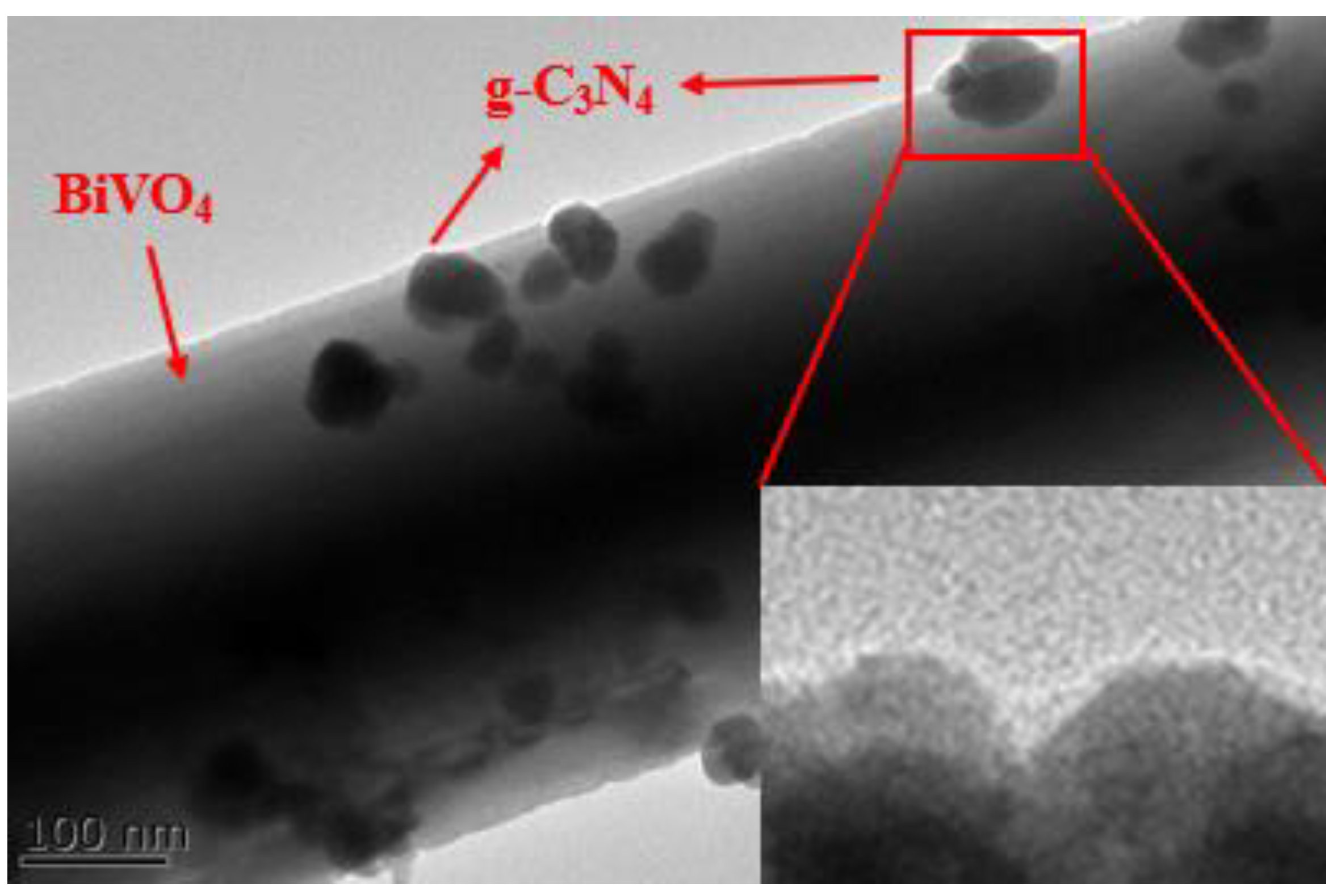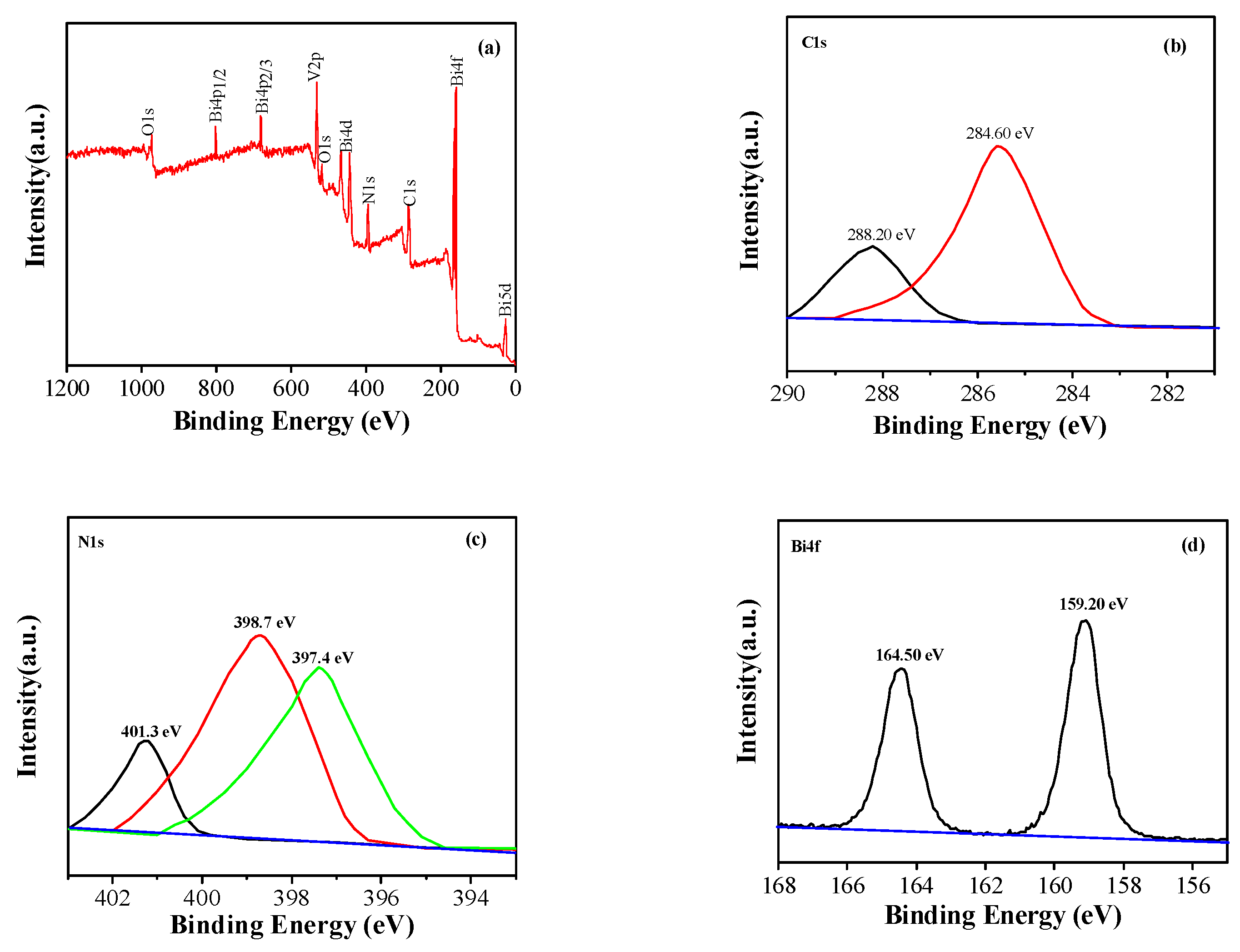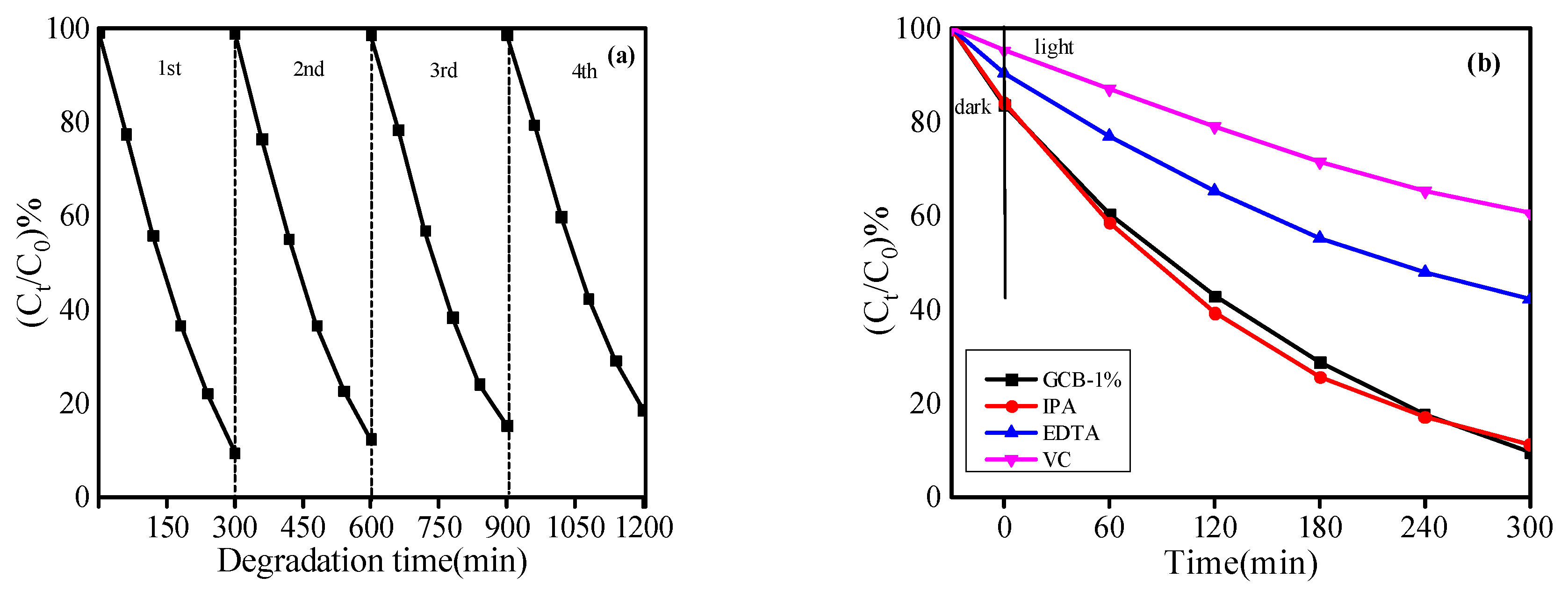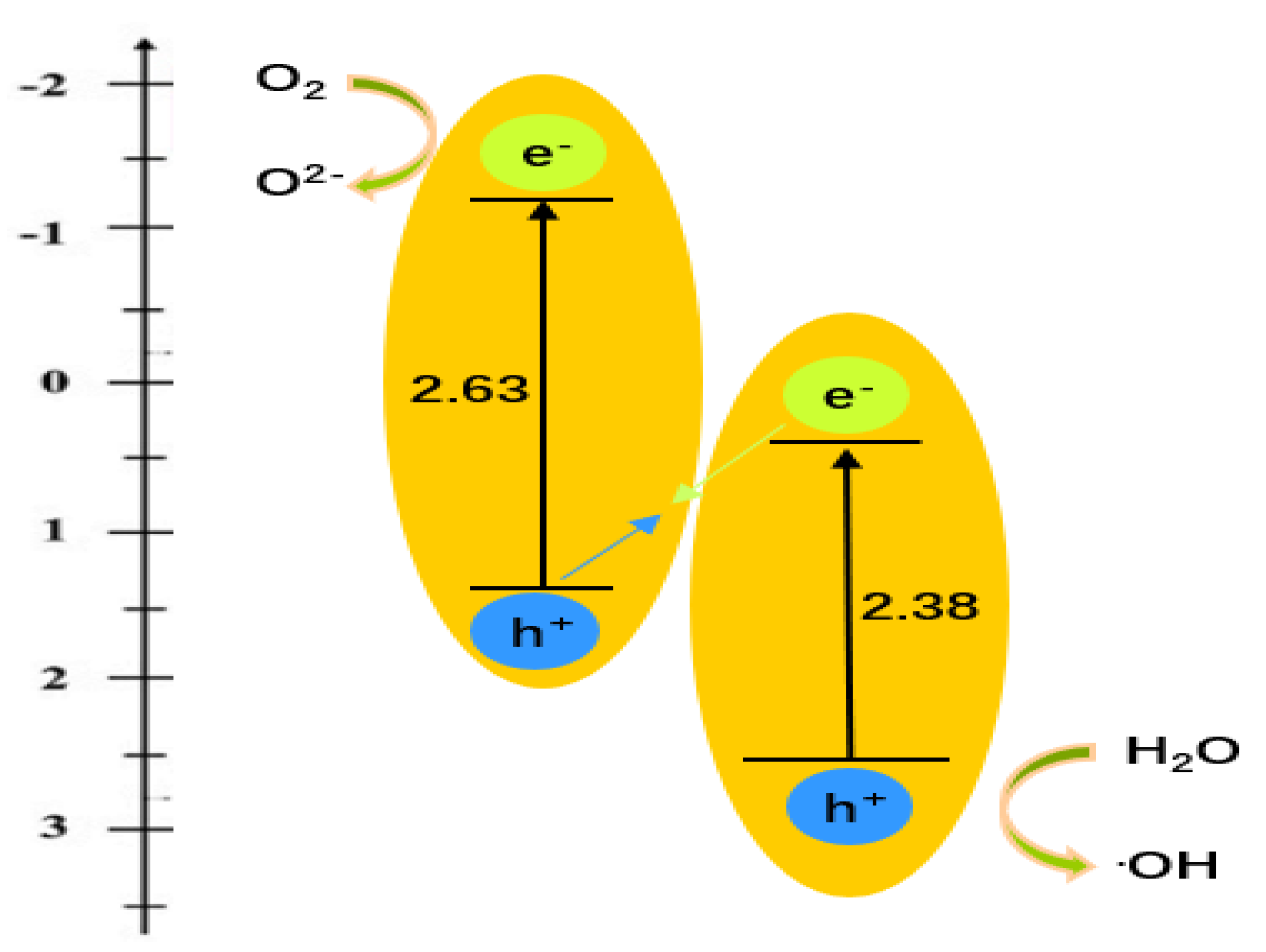Study on g-C3N4/BiVO4 Binary Composite Photocatalytic Materials
Abstract
:1. Introduction
2. Materials and Methods
2.1. The Preparation of g-C3N4
2.2. The Preparation of Sheet g-C3N4
2.3. The Preparation of g-C3N4 Tube
2.4. Three Kinds of g-C3N4 Morphologies Were Evaluated in Photocatalytic Experiments
2.5. The Preparation of BiVO4
2.6. The Preparation of Z-Type Heterojunction g-C3N4/BiVO4
2.7. Characterization Method
2.8. Evaluation of the Photocatalytic Mechanism
3. Results
4. Conclusions
Author Contributions
Funding
Data Availability Statement
Conflicts of Interest
References
- Oh, V.B.-Y.; Ng, S.-F.; Ong, W.-J. Is photocatalytic hydrogen production sustainable?—Assessing the potential environmental enhancement of photocatalytic technology against steam methane reforming and electrocatalysis. J. Clean. Prod. 2022, 379, 134673. [Google Scholar] [CrossRef]
- Ismael, M. Environmental remediation and sustainable energy generation via photocatalytic technology using rare earth metals modified g-C3N4: A review. J. Alloys Compd. 2023, 931, 167469. [Google Scholar] [CrossRef]
- Zhao, J.; Sun, J.; Meng, X.; Li, Z. Recent Advances in Vehicle Exhaust Treatment with Photocatalytic Technology. Catalysts 2022, 12, 1051. [Google Scholar] [CrossRef]
- Jarusheh, H.S.; Yusuf, A.; Banat, F.; Haija, M.A.; Palmisano, G. Integrated photocatalytic technologies in water treatment using ferrites nanoparticles. J. Environ. Chem. Eng. 2022, 10, 108204. [Google Scholar] [CrossRef]
- Liu, X.; Duan, X.; Bao, T.; Hao, D.; Chen, Z.; Wei, W.; Wang, D.; Wang, S.; Ni, B.-J. High-performance photocatalytic decomposition of PFOA by BiOX/TiO2 heterojunctions: Self-induced inner electric fields and band alignment. J. Hazard. Mater. 2022, 430, 128195. [Google Scholar] [CrossRef] [PubMed]
- Qi, F.; Yang, Z.; Qiu, Q.; Wang, Y.; Li, H. Defective TiO2 with increased photocatalytic activity synthesized by the TiO2/Ti interfacial reaction method. Surf. Interfaces 2022, 30, 101828. [Google Scholar] [CrossRef]
- Fu, J.; Zhang, X.; Li, H.; Chen, B.; Ye, S.; Zhang, N.; Yu, Z.; Zheng, J.; Chen, B. Enhancing electronic metal support interaction (EMSI) over Pt/TiO2 for efficient catalytic wet air oxidation of phenol in wastewater. J. Hazard. Mater. 2022, 426, 128088. [Google Scholar] [CrossRef]
- Guo, J.; Han, Y.; Xu, Z.; Zha, W.; Fang, J.; Luo, Q.; Liu, L.; Ma, C.-Q. Monodispersed ZnO nanoink and ultra-smooth large-area ZnO films for high performance and stable organic solar cells. Flex. Print. Electron. 2022, 7, 025013. [Google Scholar] [CrossRef]
- Liu, X.; Wang, G.; Zhi, H.; Dong, J.; Hao, J.; Zhang, X.; Wang, J.; Li, D.; Liu, B. Synthesis of the Porous ZnO Nanosheets and TiO2/ZnO/FTO Composite Films by a Low-Temperature Hydrothermal Method and Their Applications in Photocatalysis and Electrochromism. Coatings 2022, 12, 695. [Google Scholar] [CrossRef]
- Rong, X.; Lu, Y.; Yin, J.; Jiang, H.; Han, S.; Zeng, Y.; Xu, W.; Fang, M.; Cao, P.; Zhu, D.; et al. Electroluminescence enhancement of ZnO nanorod array/GaN heterojunction with MgZnO barrier layer. J. Lumin. 2022, 248, 118946. [Google Scholar] [CrossRef]
- Ren, L.; Tao, Y.; Ma, S.; Liu, Z.; Yang, M.; Wang, S.; Gao, Z.; Xie, H. Controllable preparation and photocatalytic activity of hierarchical flower-like microspheres clustered by ZnO porous nanosheets. Chem. Phys. 2022, 559, 111552. [Google Scholar] [CrossRef]
- Cao, L.; Zheng, Z.; Liu, Y.; Li, Z.; Li, Y. Special sea urchin-like CdS/g-C3N4 photocatalyst with high specific surface area and efficient charge separation. J. Mater. Sci. 2022, 57, 17609–17621. [Google Scholar] [CrossRef]
- Zhan, X.; Liu, J.; Zhao, Y.; Sun, Y.; Gao, R.; Wang, H.; Shi, H. MOF-derived tunable spin-state MnIII doped g-C3N4 photocatalysts with enhanced photocatalytic activity. Sep. Purif. Technol. 2022, 302, 122146. [Google Scholar] [CrossRef]
- Ma, Y.; Li, J.; Cai, J.; Zhong, L.; Lang, Y.; Ma, Q. Z-scheme g-C3N4/ZnS heterojunction photocatalyst: One-pot synthesis, interfacial structure regulation, and improved photocatalysis activity for bisphenol A. Colloids Surf. A Physicochem. Eng. Asp. 2022, 653, 130027. [Google Scholar] [CrossRef]
- Cheng, H.F.; Huang, B.B.; Dai, Y.; Qin, X.; Zhang, X. One-step synthesis of the nanostructured AgI/BiOI composites with highly enhanced visible- 408 light photocatalytic performances. Langmuir 2018, 26, 6618–6624. [Google Scholar] [CrossRef] [PubMed]
- Shan, W.; Liu, T. Er3+,Yb3+doping induced core-shell strutured BiVO4 and near-infrared photocatalytic properties. J. Mol. Catal. A Chem. 2016, 416, 1–9. [Google Scholar] [CrossRef]
- Hirakawa, H.; Shiota, S.; Shiraishi, Y.; Sakamoto, H.; Ichikawa, S.; Hirai, T. Au nanoparticles supported on BiVO4:effective inorganic photocatalysts for H2O2 pro- 412 duction from water and O2 undervisible light. ACS Catal. 2016, 6, 4976–4982. [Google Scholar] [CrossRef]
- Zhang, Y.Y.; Guo, Y.P.; Duan, H.N.; Li, H.; Sun, C.; Liu, H. Facile synthesis of V4+self-doped, {010}oriented BiVO4 nanorods with highly efficient visible 414 light-induced photocatalytic activity. Phys. Chem. Chem. Phys. 2018, 16, 24519–24526. [Google Scholar] [CrossRef] [PubMed]
- Zhao, Y.; Xie, Y.; Zhu, X.; Yan, S.; Wang, S. Surfactant-free synthesis of hyperbranched monoclinic bismuth vanadate and its applications in photocatalysis, gas sensing, and lithium-ion batteries. Chem.-A Eur. J. 2008, 2019, 1601–1606. [Google Scholar] [CrossRef] [PubMed]
- Zhou, F.Q.; Fan, J.C.; Xu, Q.J.; Min, Y.L. BiVO4 nanowires decorated with CdS nanoparticles as Z-scheme photocatalyst with enhanced H2 generation. Appl. Catal. B Environ. 2017, 201, 77–83. [Google Scholar] [CrossRef]
- Wang, D.; Ren, B.; Chen, S.; Liu, S.; Feng, W.; Sun, Y. Novel BiVO4/TiO2 composites with Z-scheme heterojunction for photocatalytic degradation. Mater. Lett. 2023, 330, 133229. [Google Scholar] [CrossRef]
- Liu, X.; Tang, L.; Zhou, G.; Wang, J.; Song, M.; Hang, Y.; Ma, C.; Han, S.; Yan, M.; Lu, Z. In situ formation of BiVO4/MoS2 heterojunction: Enhanced photogenerated carrier transfer rate through electron transport channels constructed by graphene oxide. Mater. Res. Bull. 2023, 157, 112040. [Google Scholar] [CrossRef]
- Minato, A.; Pan, Z.; Katayama, K.; Sohn, W.Y. Enhancement of photoelectrochemical performance of Bismuth vanadate (BiVO4)-Based photoanode by building phase-junction configurations. J. Photochem. Photobiol. A Chem. 2023, 434, 114252. [Google Scholar] [CrossRef]
- Mergen, Ö.B.; Arda, E. Determination of Optical Band Gap Energies of CS/MWCNT Bio-nanocomposites by Tauc and ASF Methods. Synth. Met. 2020, 269, 116539. [Google Scholar] [CrossRef]
- Zhou, Z.; Li, Y.; Lv, K.; Wu, X.; Li, Q.; Luo, J. Fabrication of walnut-like BiVO4 @Bi2S3 heterojunction for efficient visible photocatalytic reduction of Cr (VI). Mater. Sci. Semicond. Process. 2018, 75, 334–341. [Google Scholar] [CrossRef]
- Wu, B.; Gao, Z.; Lv, Y. Preparation of Graphite Phase Bismuth Carbon Nitride Vanadate Composites and Experimental Analysis of Free Radical Capture. IOP Conf. Ser. Earth Environ. Sci. 2021, 898, 012025. [Google Scholar]
- Lv, K.; Wan, D.; Zheng, D.; Qin, Y.; Lv, Y. Enhancement of visible light photocatalytic activity of BiVO4 by polypyrrole modification. J. Alloys Compd. 2021, 872, 159597. [Google Scholar] [CrossRef]











| The Sample Name | The Regression Equation | k | R2 |
|---|---|---|---|
| g-C3N4 | Y = 0.0010 − 0.014 x | 0.00099 | 0.9784 |
| GCB-0.3% | Y = 0.0022 − 0.0179 x | 0.00219 | 0.9915 |
| GCB-0.5% | Y = 0.0025 − 0.0134 x | 0.00251 | 0.9932 |
| GCB-1% | Y = 0.0044 + 0.0207 x | 0.00434 | 0.9959 |
| GCB-3% | Y = 0.0033 − 0.0019 x | 0.00328 | 0.9941 |
| GCB-5% | Y = 0.0012 − 0.0174 x | 0.00117 | 0.9808 |
| Semiconductors | Eg (eV) | CB (eV) | VB (eV) |
|---|---|---|---|
| g-C3N4 | 2.63 | −1.15 | 1.48 |
| BiVO4 | 2.38 | 0.47 | 2.85 |
Disclaimer/Publisher’s Note: The statements, opinions and data contained in all publications are solely those of the individual author(s) and contributor(s) and not of MDPI and/or the editor(s). MDPI and/or the editor(s) disclaim responsibility for any injury to people or property resulting from any ideas, methods, instructions or products referred to in the content. |
© 2023 by the authors. Licensee MDPI, Basel, Switzerland. This article is an open access article distributed under the terms and conditions of the Creative Commons Attribution (CC BY) license (https://creativecommons.org/licenses/by/4.0/).
Share and Cite
Li, P.; Hu, Y.; Lu, D.; Wu, J.; Lv, Y. Study on g-C3N4/BiVO4 Binary Composite Photocatalytic Materials. Micromachines 2023, 14, 639. https://doi.org/10.3390/mi14030639
Li P, Hu Y, Lu D, Wu J, Lv Y. Study on g-C3N4/BiVO4 Binary Composite Photocatalytic Materials. Micromachines. 2023; 14(3):639. https://doi.org/10.3390/mi14030639
Chicago/Turabian StyleLi, Pengfei, Yanqiu Hu, Di Lu, Jiang Wu, and Yuguang Lv. 2023. "Study on g-C3N4/BiVO4 Binary Composite Photocatalytic Materials" Micromachines 14, no. 3: 639. https://doi.org/10.3390/mi14030639






